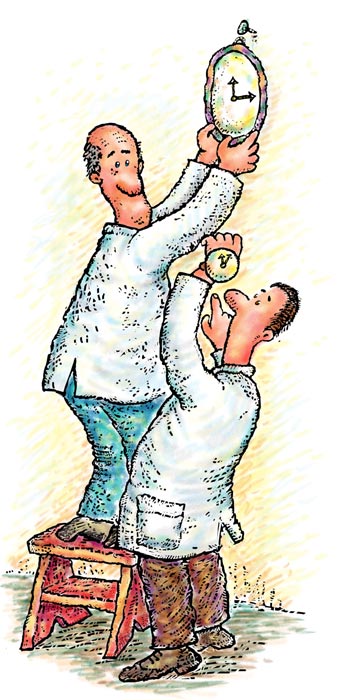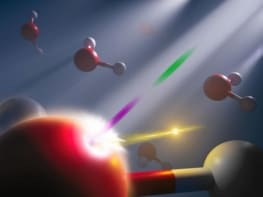
In the famous twin paradox, a sibling who journeys in a fast-moving spacecraft will return home younger than the sibling who remained on Earth. While this apparent slowing of time occurs whenever a body is set in motion, it had been much too small to be detected for movement on a human scale.
But now physicists in the US have used two of the world’s most accurate optical clocks to see this and other relativistic effects at speeds and distances on a human scale. The team has seen time slow down in a clock moving less than about 35 km/h relative to its twin. It has also showed that time speeds up in a clock that is hoisted a mere 33 cm above the other.
James Chin-Wen Chou and colleagues at the National Institute of Standards and Technology (NIST) in Boulder, Colorado used two clocks – each based on just one aluminium ion – to do their time dilation experiments. The first such clock was unveiled by the team earlier this year and has the ability to remain accurate to within one second in 3.7 billion years and the second has a similar accuracy.
Quantum logic readout
In both clocks the ion is trapped and cooled using electric fields and laser light. The frequency of the clock is given by a specific optical transition of the ion, which is measured by firing a laser at the ion and locking the laser onto that frequency at which the light is absorbed. This is done with the help of a single magnesium ion (beryllium in the second clock) that is entangled with the aluminium in a process called quantum logic spectroscopy (QLS).
To observe the time dilation at the heart of the twin paradox, the team set one of the aluminium ions into a slow oscillatory motion by adjusting the electric fields used to trap it. The ion in the other clock remained more or less stationary and when the team compared the frequency of the clocks it found that time on the moving ion slowed by a factor of about 10–16 when its average speed was about 10 m/s (35 km/h). The team repeated its measurements at different speeds between 0 and 40 m/s and found that the time dilation occurred exactly as predicted by special relativity.
The team then did a second experiment to try to see a consequence of Einstein’s general theory of relativity called “gravitational time dilation”. This occurs when one clock is elevated with respect to another and is therefore at a different value of Earth’s gravitational potential energy.
Jacking up a clock
This effect was measured by first running the clocks at a vertical difference of 17 cm and then jacking one of the clocks up by 33 cm and running them again. This revealed a shift of about 4 × 10–17 in the frequencies of the clocks – in agreement with general relativity. In human terms, this time difference adds up to about 90 billionths of a second over an 80-year life span.
To make these measurements, the team must run its clocks for tens of hours to get the required accuracy. Chou told physicsworld.com that the team is now trying to reduce this time. If successful, the clocks could be used to detect tiny variations in Earth’s gravitational potential. A network of such clocks placed around the world could, for example provide valuable information to geophysicists.
Gerald Gwinner of the University of Manitoba believes that such a network would be very useful. “The ability to connect such clocks via long-distance fibre links would indeed allow us to create a real-time network of gravitation monitors,” he explained. “Geophysics and environmental sciences could benefit enormously from such tools.”
Gwinner added that the NIST demonstration could help physicists explain time dilation to the public. “I will be able to tell the audience that now we can even see time dilation at the speed of waving an arm. Just like I waved my arm, they waved their ions back and forth.”
The work is reposted in Science 329 1630.



